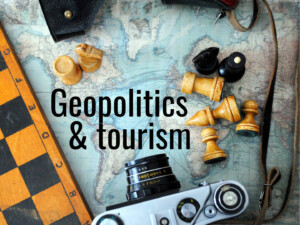Wishwashing tourism

With ‘greenwashing’ and other forms of empty rhetoric and ineffective policymaking allegedly rampant, is the travel & tourism industry, its students and consultants, engaged in ‘wishwashing’: hoping motivations and incentive structures are better aligned to our wishes than what they are in the real world?
Yes? No? Sometimes? Maybe? Offer examples.
And that is your “GT” Insight Bites challenge. Write up to 300 words about wishwashing tourism in the comments at any time. [The deadline for free copy editing, layout, and preview in time for the Bites compilation has passed.]
UPDATE March 19, 2025 — Your “Good Tourism” Insight Bites
Bites menu
- ‘Sustainability fatigue’: When wishes fail
- From wish to real-world alignment
- Sustainability starts in the classroom
- Sustainability is a work in progress
- The think-do gap in sustainable travel
- ‘Not only unfair but also dismissive’
- For women: Is tourism a powerful tool, or an unfulfilled promise?
- ‘Bridging the gap between vision and reality’
- ‘Make smaller promises that have bigger local impacts’
- ‘Stop viewing sustainability as a performance’
- “GT” Insight BiteX (‘X’ is up to you)
- ‘The White Lotus’ effect: Thailand’s tourism boom or bust?
- What do you think?
- Featured image (top of post)
- Previous “GT” Insight Bites
‘Sustainability fatigue’: When wishes fail
Wolfgang Georg Arlt, CEO, COTRI (China Outbound Tourism Research Institute); Director, Meaningful Tourism Center, Nepal
Medical science delays individual death; a sustainable economy delays species extinction.
Open LinkedIn and social media, and you’ll find countless posts: “If only tourists would understand sustainability,” or “Travellers are learning!”, believing this solves climate change and overtourism.
Wishing for a better world is noble, but as effective as writing to Santa or burning incense. Many tire of “green” talk without seeing positive impact, despite eating less meat, cycling, and taking trains.
We must communicate that all efforts are vital, but our goal is to delay tipping points like the collapse of the Atlantic Meridional Overturning Circulation (AMOC) or permafrost thaw.
This concept mirrors medicine, where we extend life, knowing death is inevitable. Reaching 80 or 90 years instead of 30 or 40 is valued, as it should be with our planet’s lifespan.
‘Wishwashing’ — telling people small actions will fix everything — leads to ‘sustainability fatigue’. Believing stopping flights (done by few) or recycling toilet water (impossible for many) will save us is dangerous. It ignores the scale of the problem.
The gap between individual action and systemic change must be acknowledged. We need to focus on large scale industrial change, as well as behavioural change.
We must push for sustainable aviation fuel and a circular economy, but with the clearly communicated goal of prolonging humanity’s existence, knowing the point of no return is likely past. We fight to delay, not prevent, our eventual fate, mirroring the dinosaurs.
We must be honest about the challenges. We need to make it clear that the goal is to buy time, and that we must use that time wisely.
From wish to real-world alignment
K Michael Haywood, publisher, ‘Destinations-in-Action’, Canada
Consultants are hired to help fulfill wishes in real world settings. Failures are rarely admitted and never discussed in public. So why now? Post-mortems on misalignments determine how idealism might find common ground with the practicalities of realism.
Here are two projects (that I completed four decades ago) that failed to be appropriately implemented:
- A redesign of the Guelph Multicultural Festival, and
- The development of a Strategic Tourism Plan for Elora, Ontario.
Let’s start with the terms of reference. Questions arose, changes were made, our proposals were accepted and everything seemed hunky-dory. Projects proceeded as planned; relations with clients remained amicable; final reports and recommendations were delivered on time and with applause at community meetings.
Then, virtually no word from anyone. We wondered, what went wrong? What did we not do?
Now we know.
- Pre-mortems need to ascertain and understand the needs, wants, expectations and culture of each stakeholder group…even those who might be in opposition.
- Communications must be ongoing and transparent; hidden agendas exposed; the explicit and implicit purpose(s) and ambitions of those in control need to be known.
- Costs/benefits and derived value — materially, economically, financially, socially, culturally, sustainably — must be in evidence prior to, and on completion of, the project.
- Instabilities: Forces or trends that could derail the project need to be ascertained.
- The real challenge requires deep knowledge of expected performance to be derived from a range of possible product/market fits.
- A clear appreciation of the clients‘ operating systems and cultures predetermines success, the willingness and capability to implement the recommendations.
Perhaps Adele‘s song, “Rolling in the Deep”, best expresses the depth of despair that comes from the obstacles that hinder dreams from being fulfilled. We could’ve had it all … If only …
Sustainability starts in the classroom
Regina Raj, Vice Principal, an international school, Indonesia
The travel & tourism industry loves to wear a green halo, but is it truly committed to sustainability or just engaging in wishwashing, a glossy illusion of progress?
It’s a can of worms no one really wants to open, but here we are.
Students take sustainability seriously, caring about responsible tourism, ethical business practices, and protecting the environment. Yet, they often grow frustrated when they realise that many businesses focus more on appearances than real impact.
Are they truly committed, or just saying what sounds good?
Many young professionals enter the industry wearing rose-coloured glasses, hoping to drive change, only to face greenwashing, cost-cutting, and resistance to real sustainability efforts.
Some businesses and governments have taken steps forward, but is it enough? Without real commitment, wishwashing will continue.
I remember the fiasco created by Marriott International’s announcement that by 2019, it would remove plastic straws and stirrers from its hotels to cut waste.
The move was meant to reduce plastic waste. Yet, while they proudly ditched plastic straws, they conveniently kept stocking their hotels with tiny plastic toiletry bottles and excessive packaging because, apparently, straws were the only real problem.
If Marriott’s goal was truly sustainability, why stop at plastic straws?
If we want real change, sustainability must start in schools. From kindergarten to secondary school, children should learn to value green practices as a way of life, not just a trend.
A great example is Singapore’s Eco-Schools Programme, which teaches students waste reduction, energy saving, and eco-tourism.
If we teach these values early, young people won’t just hope for sustainability, they’ll demand it, question greenwashing, and push for real change.
Is the industry prepared for a future where greenwashing no longer fools anyone?
Sustainability is a work in progress
Krizia Clemente, Product and Account Manager, Khiri Travel Vietnam
The travel industry is genuinely striving for more sustainable and responsible practices, though there will always be room for growth.

The concept of ‘wishwashing’ can be seen when good intentions are in place, but the gap between goals and real-world execution can feel wider than expected.
For example, many companies in the travel and tourism industry are increasingly promoting eco-friendly tours and sustainability initiatives. While these efforts are encouraging, the infrastructure in some destinations is not yet fully equipped to support sustainable practices. Nevertheless, this is a positive sign that the industry is beginning to recognise the importance of sustainability, though it remains a work in progress.
Similarly, there is a growing focus on initiatives that promote cultural sensitivity and responsible tourism. More and more travel businesses are working to create connections with local communities and entrepreneurs. While some existing structures may harm the environment and disrupt local communities, there is an increasing emphasis on giving local businesses a voice, which in turn creates more meaningful opportunities for them.
Lastly, travellers are more conscious than ever about sustainability, which is pushing the industry to meet these expectations. Often, eco-friendly travel options can be more expensive, but there is a growing demand, and this is obliging companies to make these options more accessible and affordable over time.
The travel industry is actively working to align its motivations with sustainable practices. While we’re still evolving, the journey towards more meaningful and responsible tourism is well underway. The key is to keep building on these positive steps, knowing that small changes can lead to big impacts in the long run.
[Khiri Travel is a valued “Good Tourism” Partner]
The think-do gap in sustainable travel
Greg Richards (Tilburg University) & Wendy Morrill (WYSE Travel Confederation), The Netherlands
Youth travel research reveals a stark ‘think-do gap’ in sustainability. Despite expressing strong environmental concerns, young travellers’ actions often contradict their stated intentions. The WYSE New Horizons survey highlights this paradox.
A growing number of 16 – 29-year-olds prioritise sustainable travel, with nearly a quarter deeming it “extremely important” in 2023, up from 15% in 2017. However, this concern rarely translates into concrete action.
Even environmentally-aware individuals travel frequently, with only 3.6% likely to purchase carbon offsets and 6.1% buying eco-friendly products. Notably, 65% reported no environmental concerns, even when travelling by air.
A striking 60% of those who claimed sustainable travel was “extremely important” admitted environmental concerns did not influence their travel behaviour. Travellers desiring sustainable lifestyles travel just as often as others. Frequent international trips are common among those claiming environmental awareness.

Only those who developed personal awareness of their environmental impact during their trips (35%) reduced their travel frequency.
Measuring the ‘think-do gap’ is difficult. Those acting on personal awareness travel less and may be underrepresented in typical travel surveys. Yet, these individuals are more likely to support sustainability initiatives when they do travel.
Is closing this gap a matter of fostering awareness through travel experiences, ironically, or providing more accessible sustainable options? Does the prevalence of ‘wishwashing’ obstruct the travel industry from effectively addressing this discrepancy?
‘Not only unfair but also dismissive’
Dorji Dhradhul, author and creativist, Bhutan (former Director General, Bhutan Tourism)
The idea that tourism professionals, students, and consultants are engaging in “wishwashing” is not only unfair but also dismissive of the real work being done in the industry. As a tourism professional myself, I firmly believe that the majority of us are deeply committed to sustainable, responsible, and meaningful tourism practices.
While greenwashing does exist, it does not mean that the entire travel & tourism sector operates on empty rhetoric. Many organisations and individuals are making tangible efforts to align business goals with sustainability.
Take, for instance, the community-based tourism initiatives in Bhutan. Companies like travel.bhutan have made strong commitments to responsible tourism integrating sustainable practices into their core operations rather than just using them as marketing tools.
Tourism students and consultants are also driving change. Universities now emphasise sustainability in their curricula, and consultants work actively to help businesses transition towards greener models.
If we were merely engaged in wishful thinking, we wouldn’t see major hotel chains eliminating single-use plastics or destinations enforcing stricter visitor regulations to protect fragile ecosystems, such as overtourism measures in Venice or the Galápagos.
The reality is that true tourism professionals recognise the need for action, not just words. We acknowledge challenges, but we work towards practical solutions. Dismissing these efforts as “wishwashing” undermines the dedication of those genuinely striving for a better tourism industry.
If some individuals are only pretending to care, they do not represent the field. The rest of us are in this for real, and our work speaks louder than empty accusations.
A great example is Bhutan’s sustainable tourism policy and practice of ‘High Value Low Volume’, where a visitor pays USD 100 per day as a sustainable development fee. If paying USD 100 per day per person is not authentic, what is?
For women: Is tourism a powerful tool, or an unfulfilled promise?
Shamiso Nyajeka, Head of Department, Kirirom Institute of Technology, Cambodia
March is a time to celebrate women’s achievements, reflect on progress, and discuss ongoing challenges. Conferences and discussions take place worldwide, but how many of the most vulnerable women even know these conversations are happening? How many are aware of the policies and conventions designed to empower them? More importantly, how effective are these in addressing real challenges?
With less than five years until 2030, the deadline for the UN Sustainable Development Goals (SDGs), tourism continues to be championed as a driver of most of the goals, including Goal 5: Achieve gender equality and empower all women and girls. It is hailed as a tool for economic empowerment, offering jobs, financial independence, and opportunities for women to thrive.
This narrative often highlights inspiring success stories, like women-led cooperatives in Cambodia, Turkey, and Morocco, or the financial independence gained by Maasai women through cultural tourism in Kenya. But, as educators shaping future industry leaders, could we be unintentionally presenting an idealised version of tourism’s role? Are we creating false expectations by overly focusing on these success stories without fully addressing the industries’ deeper inequalities?
Tourism does create jobs for women, but many are low-paying, seasonal, and insecure. Women remain underrepresented in leadership and ownership, while gender-based violence, exploitation, and workplace harassment persist. Barriers such as limited access to capital, training, and networks further hinder women entrepreneurs. Intersectional factors — race, ethnicity, and disability add additional layers of disparity.
Are we glossing over these systemic issues, which policies alone cannot fix? Could we be setting up our students for disillusionment when they enter the industry and face reality?
Tourism can be a powerful tool for gender equality, but only if we acknowledge and address these uncomfortable truths. Otherwise, will it remain another unfulfilled promise?
‘Bridging the gap between vision and reality’
Ivana Damnjanović, sustainable & transformational travel expert, educator, researcher, & experience designer; co-owner, Tchardak Brewery, Serbia
There are two sides to this coin: hope and disillusionment. Both shape our personal and professional journeys, individually and collectively as an industry.
Hope fuels our aspirations. Without it, wishes, goals, and the paths to achieving them would be meaningless. Hope lets us strive, believing change is possible. But can we be blamed for wanting the world to play along with our vision?
This is where ‘wishwashing’ comes in; the tendency to believe that motivations and incentive structures are better aligned with our aspirations than they truly are.
In travel & tourism, we celebrate sustainability initiatives, destination stewardship, and transformational travel. Over decades, we have built frameworks like the Sustainable Development Goals (SDGs) and experience design for behaviour change. But are these aspirations driving real transformation, or are we selectively seeing progress through an optimistic lens?
In a VUCA (volatile, uncertain, complex, and ambiguous) world, we sometimes shield ourselves through cognitive bias, or by staying within like-minded circles. This can make scattered sustainability efforts seem more impactful than they are. For instance, a destination may highlight its commitment to sustainability while failing to address mass tourism’s underlying structural issues.
The reality check is unavoidable: tourism’s sustainability efforts have yet to be truly effective. Acknowledging this often leads to disillusionment.
But we have a choice: to face reality with eyes wide open, or closed. That choice does not absolve us from trying harder and wiser. On the contrary, it demands it.
Finally, as educators — whether mentoring students or professionals — we must nurture hope while also exposing what doesn’t work. Hope without action breeds complacency, but facing hard truths can be a springboard for transformation.
Recognising wishwashing is the first step in bridging the gap between vision and reality.
‘Make smaller promises that have bigger local impacts’
Natalie Van Ogtrop, Sustainability Manager, YAANA Ventures, Thailand
It is easy to accidentally fall into greenwashing nowadays, or in this case wishwashing, because all tourism businesses are pushed to include sustainability within their business models; students at universities are encouraged to think about sustainability in all shapes and forms; and consultants are often not taken seriously at all if they fail to mention the term ‘sustainability’.

Obtaining sustainability certification and participating in a carbon offset program are good examples of the most frequent initiatives businesses take part in. These are definitely a good starting point, however, holding a certificate or contributing to an offset pool is not necessarily going to make the world a better place.
It’s about all the other initiatives a business decides to actively participate in. I say ‘actively’ because there is a big difference between reporting something for the sake of reporting, and going out there and taking action to protect or restore the environment, or to improve the lives of local communities.
To avoid wishwashing, businesses can make smaller promises that have bigger local impacts. They can start by committing to help one family, small business, or local program, defining what a successful outcome would look like, and expanding once they have achieved their goal.
By actively engaging with surrounding communities and making use of the resources readily available, businesses can effect greater change than through a carbon offsetting program over which they have less control.
At the end of the day, almost everyone in the travel & tourism industry is trying their best to contribute to a more sustainable future.
‘Stop viewing sustainability as a performance’
Chris Kittishinnakuppe, Head of Marketing & Sales, VHG Hospitality Asia, Thailand
All things considered, the travel & tourism business is headed toward a better future. But that’s only if we see real change.

To that end we must give up empty dreams and concentrate on explicit local pledges. Local initiatives, when supported and nurtured, have the potential to drive significant change and bring about a more sustainable future for the travel industry. This potential should give us hope and optimism for the future of sustainable tourism.
Direct action toward a certain end is quite different to ‘wishwashing’, where we mistakenly believe that incentives and motivations align more with our goals than they genuinely do. Like ‘greenwashing’, which typically involves overstating environmental efforts, ‘wishwashing’ is when we overstate the importance of well-meaning but ineffectual initiatives along any hoped-for outcome: environmental, social, cultural, financial, or anything else.
Certification and carbon offsets are great beginning points for companies pursuing sustainability, for example, but they will not be enough to bring about long-term change in and of themselves. Beyond certification and offsets, the extent and depth of a company’s direct action to establish a more sustainable operating environment defines its real value.
Companies must stop viewing sustainability as a performance and instead focus on making fundamental changes. This shift in perspective can inspire and motivate companies to take significant actions, rather than, for example, depending on some distant program over which they have little direct influence.
There is a leadership-by-example element to direct local action too. Other stakeholders will be more prepared to increase their involvement when they see good, positive change occurring in their neighbourhood.
“GT” Insight BiteX (‘X’ is up to you)
The “Good Tourism” Blog offers a great opportunity to any travel & tourism stakeholder who wishes to express themself in writing for the benefit of “GT’s” open-minded readers.
To feature in the next “GT” Insight Bites compilation, send no more than 300 words (300 words or fewer (</=300 words)) on any tourism-related idea or concern you may have.
Don’t use AI. if you lack confidence in writing in plain English, “GT’s” publisher will personally help with copy editing. “GT” doesn’t judge. “GT” publishes.
Send your “GT” Insight Bite and picture to [email protected].
‘The White Lotus’ effect: Thailand’s tourism boom or bust?
Anishka Narula-Nielsen, founder, Roots and Routes Consulting, UK
HBO’s The White Lotus is the latest pop culture phenomenon to fuel a tourism surge. This time, Thailand takes centre stage, with luxury resorts in Koh Samui, Phuket, and Bangkok already seeing a spike in interest immediately after the release of the first two episodes.
It’s exciting, but also concerning.
We have seen this before. The Beach turned Maya Bay into an over-touristed casualty. Venice, Dubrovnik, and Bali have all felt the double-edged sword of a Hollywood spotlight.
When a destination goes viral, it attracts travellers, which is great until it isn’t. Without thoughtful management, it can erode the very experience that made it desirable.
During the pandemic and its aftermath, Thailand’s ecosystems had time to breathe. Maya Bay’s closure allowed its marine life to regenerate. Many other destinations had a chance to reset. Are we about to undo that progress?
Instead of falling into the same overtourism traps, Thailand has a chance to take a different path to ensure that The White Lotus benefits destinations without overwhelming them.
How can we help spread the economic benefits and preserve the integrity of these places?
- Encourage visitor dispersal beyond Koh Samui and Phuket,
- Implement sustainable tourism limits at fragile hotspots, and
- Promote locally-owned experiences.
Resorts can play a role by integrating conservation initiatives into guest stays, ensuring that high-end travel contributes to long-term sustainability rather than short-term strain.
Thailand does have a rare second chance. The White Lotus effect can be a boon, not a bust, but only if the industry plays it right. The question is: Will they seize the opportunity?
What do you think?
In a comment below share your own thoughts about wishwashing in travel & tourism. SIGN IN or REGISTER first. (After signing in you will need to refresh this page to see the comments section.)
Or write a “GT” Insight or “GT” Insight Bite of your own. The “Good Tourism” Blog welcomes diversity of opinion and perspective about travel & tourism, because travel & tourism is everyone’s business.
This is an open invitation to travel & tourism stakeholders from any background to share their thoughts in plain English with a global industry audience.
“GT” doesn’t judge. “GT” publishes. “GT” is where free thought travels.
If you think the tourism media landscape is better with “GT” in it, then please …
Featured image (top of post)
Wishwashing tourism. Image by Michaela, at home in Germany • Thank you very much for a like (CC0) via Pixabay.
Previous “GT” Insight Bites
- Butler’s conundrum: Air travel and ‘sustainable’ tourism
- What is tourism’s biggest opportunity and/or threat where you are in 2025?
- “GT” Insight Bites: Nostalgia
- “GT” Insight Bites: Geopolitics and tourism
- Tourism stakeholders: Who has an outsized voice? Who has no voice? Who cares?
- Would you abolish taxes on tips?
- Three critics walk into a bar …
- How are emerging technologies transforming the travel & tourism industry?
- What does it mean to be critical of tourism?
- What constitutes ‘progress’ for travel & tourism in 2024?
- Considering a career in tourism? Important things you should know in 2024
- What did tourism learn from the COVID-19 pandemic?
- In 2024, what are the best opportunities for tourism over the next five years?
- Tourism’s biggest challenges & threats over the next five years to 2028
- On empowerment, promotion, and the power of expression
- On enrichment, repatriation, the double-edged blade, and war
- On tourism technology, progress, and local benefit-sharing
- Hey, travel & tourism, are you ‘neocolonialist’?
- Who’s the new boss? Asia Pacific tourism industry association seeks leader
- ‘The hospitality industry offers a great career.’ Really?
- Cruise ships: Blessing or blight?
- Tourist vs traveller: What’s the difference?
- The heads of finance, operations, and PR walk into their boss’s office …
- Yes, Tourism Minister
- What are tourism’s biggest challenges & threats over the next five years?
- ‘Tourism is built on the backbone of white supremacy’. What do you think?
- Really, what’s the difference? ‘Sustainable tourism’ vs ‘regenerative tourism’
- Want a career in tourism? Important things you should know
- Diverse perspectives on travel & tourism and a fairer world
- Diverse perspectives on economic degrowth and tourism
- Diverse perspectives on visitor dispersion













